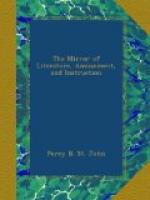The Osprey.
It would appear that the Americans are very fond of these birds, from some prevalent superstition connected with them. “It has been considered,” says Dr. S. Mitchill, of New York, “a fortunate incident to have a nest and a pair of these birds on one’s farm. They have, therefore, been generally respected, and neither the axe nor the gun has been lifted against them. Their nest continues from year to year. The same couple, or another, as the case may be, occupies it season after season. Repairs are duly made; or, when demolished by storms, it is industriously rebuilt. There was one of these nests, formerly, upon the leafless summit of a venerable chestnut-tree, on our farm, directly in front of the house, at the distance of less than half a mile. The withered trunk and boughs, surmounted by the coarse-wrought and capacious nest, was a more picturesque object than an obelisk; and the flights of the hawks, as they went forth to hunt, returned with their game, exercised themselves in wheeling round and round, and circling about it, were amusing to the beholder, almost from morning till night. The family of these hawks, old and young, was killed by the Hessian jagers. A succeeding pair took possession of the nest; but, in the course of time, the prongs of the trunk so rotted away that the nest could no longer be supported. The hawks have been obliged to seek new quarters. We have lost this part of our prospect, and our trees have not afforded a convenient site for one of their habitations since."[4]
[4] Wilson, Amer. Ornith. v. 15.
Herons and Heronries.




